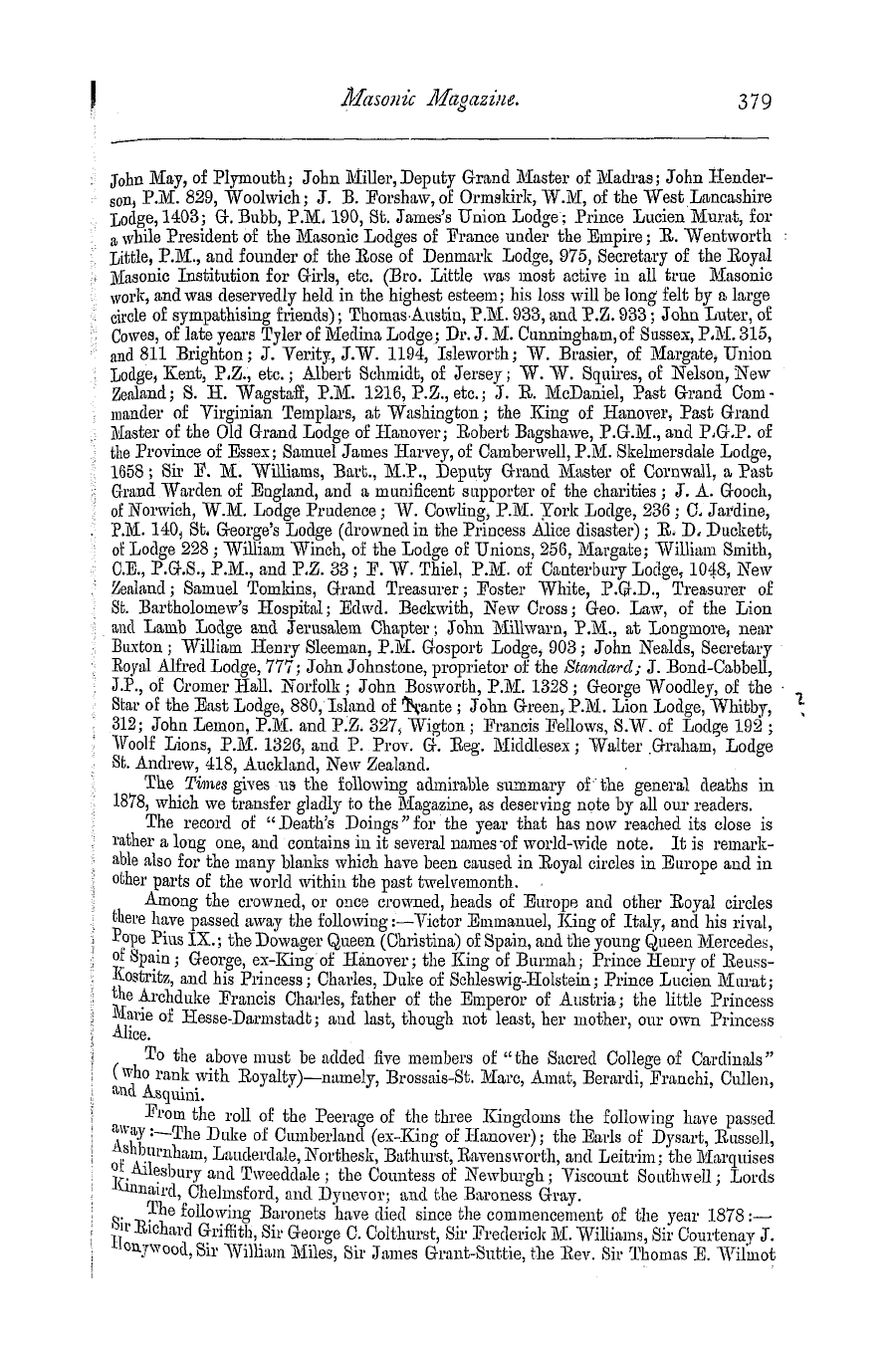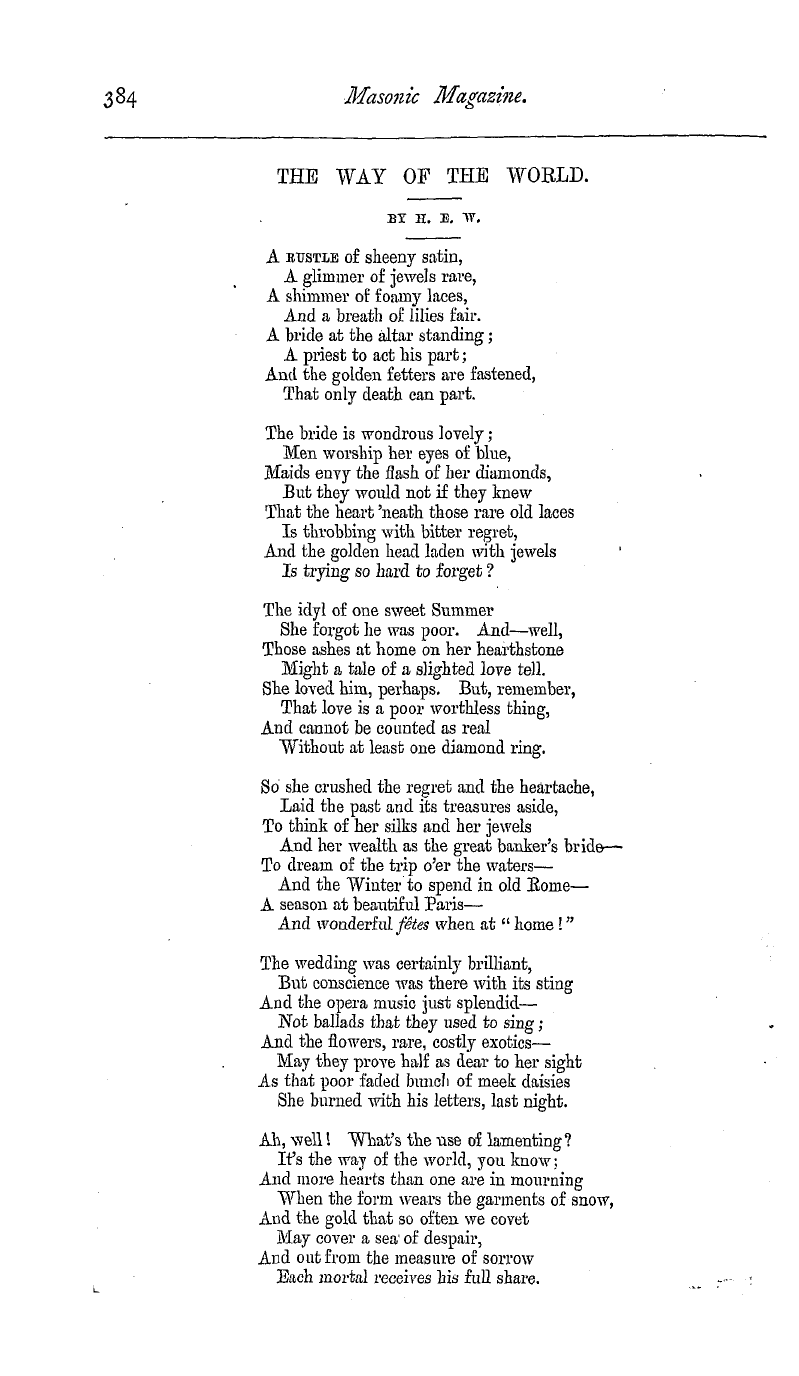-
Articles/Ads
Article THE SCOTTISH CRADLE OF FREEMASONRY* ← Page 2 of 4 →
Note: This text has been automatically extracted via Optical Character Recognition (OCR) software.
The Scottish Cradle Of Freemasonry*
recesses of the " forest primeval" AA'ere lighted by the beal-fire , and AAdtnessed the bloody rites of antique superstition . There is every reason to believe that ¦ the Abbey of Kilwinning is one . of the few religious houses which can trace a distinct connection with the early hagiology of Scotland . A ccenobium or monastery existed there at least as early as the opening years of the sei'entli century ; and this AA'as in all probability one of those religions centres Avhich oived their existence to the eA'angelistie labours of the
Culdees , for St . Winning , ivho gaA'e his name to the spot , is believed to haA'e been one of that noble band of primitive Christian missionaries AVIIO carried the Gospel message in its single integrity to the people of Scotland centuries before Augustine landed from Bonie on the shores of Kent . St . Winning had received his training for the ministry from Columba in the school of the prophets Avhich that great teacher founded in the island of Iona . " Is it too fanciful to suppose , " asks the author of the book Avhich
has suggested these remarks , " that the religions fervour of the South-Avestern Lowlands , AA'hich found eA'er-memorable expression in the revolt against Prelacy in the seventeenth century , may have been at first kindled by St . Winning and others such as he , Avho Avere animated hy a spirit of Christian self-sacrifice ? Is it too fanciful to suppose that to this remote , yet fidl-AA'elling fountain-head of change , the piety of so many succeeding generations may be traceable ? As a fact these proto-missionaries
came to the West—to that isle of the Hebrides Avhere the Church of Iona AA'as founded—later to A'arious points alon g the Western coasts ; and , also , as a matter of fact , the men of the West have been historically distinguished for the ardour of their religious prepossessions . " This thought , which we accept as much more than a mere fancy , is indeed one Avhich , as Mr . Wylie justly adds , makes the name of Winning smell " SAveet as buds in spring , though his body has lain in the dust for more than a thousand years . "
On the site of St . Winning ' s Kirk ( for the word " cell , " as it is now understood , conveys an utterly erroneous impression ) , the JNTorman Sir Hugh de Morville , High Constable of Scotland , built the Abbey in the year 1140 . According to Timoth y Pont , it Avas a " faire and staitely " structure , " after ye modell of yat of GlasgOAv , with a fair stei ple of sei'en score foote of hei ght yet standing quhen I myselve did see it "Avhich AA'as towards the close of the sixteenth century . The monastery Avas one of the
richest ecclesiastical establishments in Scotland , enjoying revenues equal to . £ 20 , 000 sterling ; but at the Eeformation short Avork was made both with the edifice and the princely income of the priests , only a remnant of the former being left to indicate its ori ginal splendour , and the latter being distributed amongst the local aristocracy .
The presumption is , of course , that KihA'hming became the cradle of Scottish Freemasonry in-connection Avith the building of the Abbey , the "Mystery" . being introduced by an architect or master-mason from the Continent . ' Unfortunatel y the Cartiil ' ary of the Abbey has been lost . But the masons' marks oh the broken Avails and
mouldering ashes of the : ' Abbey—lithographed copies of AA'hich Mi \ Wylie ' has reproduced from the minute books of . Mother Kilwinning— : are varied and numerous , some A'ery beautiful in design ; and they form a chapter of- special interest to the craftsmen ' . A contract in the archives of the Grand Lodge of Scotland proi'es that , the Lodge of Scoon and Bertha , UOAV Scoon and Perth , proceeded from the Lodge of Kilwinning about 1193 . The documentary evidence , hoAveA'er , is exceedingly scanty : and it need hardl y excite
surprise to find that the obscurity in AA'hich the birth of the Mother Lodge is shrouded has led to many contiwersies , most of them conducted AA'ith quite unneces-™ y heat , and some of them never likely to be permanently settled . As much as 18 possible in the AA'ay of soiling the questions in dispute seems to haA'e been accomplished in the A'olume before us . Mr . Wylie entered upon his task Avith the modest design of furnishing his brethren with small brochure the Mother Lod and
a on ge a leiv notes on the Abbey ; but the Avork giw on his hands , and the result noiv lies on 01 ir - table in the shape of a handsome and richly illustrated book of nearly 400 pages , nito AA'hich he has gathered all the materials available for forming a judgment on the A'arious points in dispute . His regard for the Mother Lodge , previously evinced b y many years of devoted sendee in the promotion of her interests , is too
Note: This text has been automatically extracted via Optical Character Recognition (OCR) software.
The Scottish Cradle Of Freemasonry*
recesses of the " forest primeval" AA'ere lighted by the beal-fire , and AAdtnessed the bloody rites of antique superstition . There is every reason to believe that ¦ the Abbey of Kilwinning is one . of the few religious houses which can trace a distinct connection with the early hagiology of Scotland . A ccenobium or monastery existed there at least as early as the opening years of the sei'entli century ; and this AA'as in all probability one of those religions centres Avhich oived their existence to the eA'angelistie labours of the
Culdees , for St . Winning , ivho gaA'e his name to the spot , is believed to haA'e been one of that noble band of primitive Christian missionaries AVIIO carried the Gospel message in its single integrity to the people of Scotland centuries before Augustine landed from Bonie on the shores of Kent . St . Winning had received his training for the ministry from Columba in the school of the prophets Avhich that great teacher founded in the island of Iona . " Is it too fanciful to suppose , " asks the author of the book Avhich
has suggested these remarks , " that the religions fervour of the South-Avestern Lowlands , AA'hich found eA'er-memorable expression in the revolt against Prelacy in the seventeenth century , may have been at first kindled by St . Winning and others such as he , Avho Avere animated hy a spirit of Christian self-sacrifice ? Is it too fanciful to suppose that to this remote , yet fidl-AA'elling fountain-head of change , the piety of so many succeeding generations may be traceable ? As a fact these proto-missionaries
came to the West—to that isle of the Hebrides Avhere the Church of Iona AA'as founded—later to A'arious points alon g the Western coasts ; and , also , as a matter of fact , the men of the West have been historically distinguished for the ardour of their religious prepossessions . " This thought , which we accept as much more than a mere fancy , is indeed one Avhich , as Mr . Wylie justly adds , makes the name of Winning smell " SAveet as buds in spring , though his body has lain in the dust for more than a thousand years . "
On the site of St . Winning ' s Kirk ( for the word " cell , " as it is now understood , conveys an utterly erroneous impression ) , the JNTorman Sir Hugh de Morville , High Constable of Scotland , built the Abbey in the year 1140 . According to Timoth y Pont , it Avas a " faire and staitely " structure , " after ye modell of yat of GlasgOAv , with a fair stei ple of sei'en score foote of hei ght yet standing quhen I myselve did see it "Avhich AA'as towards the close of the sixteenth century . The monastery Avas one of the
richest ecclesiastical establishments in Scotland , enjoying revenues equal to . £ 20 , 000 sterling ; but at the Eeformation short Avork was made both with the edifice and the princely income of the priests , only a remnant of the former being left to indicate its ori ginal splendour , and the latter being distributed amongst the local aristocracy .
The presumption is , of course , that KihA'hming became the cradle of Scottish Freemasonry in-connection Avith the building of the Abbey , the "Mystery" . being introduced by an architect or master-mason from the Continent . ' Unfortunatel y the Cartiil ' ary of the Abbey has been lost . But the masons' marks oh the broken Avails and
mouldering ashes of the : ' Abbey—lithographed copies of AA'hich Mi \ Wylie ' has reproduced from the minute books of . Mother Kilwinning— : are varied and numerous , some A'ery beautiful in design ; and they form a chapter of- special interest to the craftsmen ' . A contract in the archives of the Grand Lodge of Scotland proi'es that , the Lodge of Scoon and Bertha , UOAV Scoon and Perth , proceeded from the Lodge of Kilwinning about 1193 . The documentary evidence , hoAveA'er , is exceedingly scanty : and it need hardl y excite
surprise to find that the obscurity in AA'hich the birth of the Mother Lodge is shrouded has led to many contiwersies , most of them conducted AA'ith quite unneces-™ y heat , and some of them never likely to be permanently settled . As much as 18 possible in the AA'ay of soiling the questions in dispute seems to haA'e been accomplished in the A'olume before us . Mr . Wylie entered upon his task Avith the modest design of furnishing his brethren with small brochure the Mother Lod and
a on ge a leiv notes on the Abbey ; but the Avork giw on his hands , and the result noiv lies on 01 ir - table in the shape of a handsome and richly illustrated book of nearly 400 pages , nito AA'hich he has gathered all the materials available for forming a judgment on the A'arious points in dispute . His regard for the Mother Lodge , previously evinced b y many years of devoted sendee in the promotion of her interests , is too















































